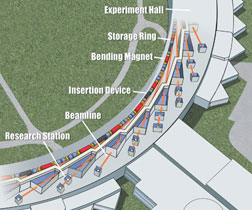| What is the APS? |
|
The Advanced Photon Source is a synchrotron light source that produces high-energy, high-brightness x-ray beams. The source is optimized to put large quantities of high-energy photons into a very small area in a very short time. The x-ray beam is customized at each beamline to meet particular needs. With more than 60 beamlines already operational, and more under development, the APS offers an exceptionally broad range of experimental conditions at a single facility. It is also conveniently located at Argonne National Laboratory, 30 miles southwest of Chicago, Illinois, with two nearby airports offering many travel options. Scientists from around the world come to the APS to conduct forefront basic and applied research in the fields of materials science; biological science; physics; chemistry; environmental, geophysical, and planetary science; and innovative x-ray instrumentation. The APS is one of several leading user facilities located at Argonne. These facilities, which include capabilities in nanoscience, electron microscopy, and high-performance computing, are also available to support your research, and many of the access procedures are shared with APS. |
| What experimental conditions and techniques are available? |
|
Each beamline at the APS offers a unique combination of capabilities, but some of the main considerations are energy range and tunability, special sample environments, time structures, and beam size. Specifics for each beamline and a directory of techniques can be found in the Beamlines section; however, the techniques and capabilities evolve continually. The following are some highlights.
|
| How is beam time made available? |
|
The machine operates for 3 three-month runs (or cycles) each year, with a one-month shutdown between runs. The runs typically span February to April, June to August, and October to December. Many beamlines are managed directly by the APS. Others are managed by Collaborative Access Teams (CATs), which are made up of scientists from universities, industry, and research laboratories. All beamlines offer time to the international scientific community. In general, the APS makes beam time available in three ways. Specific requirements govern each mode of access.
|
| What are the requirements? |
|
Publication. For General User research that will be published in the open literature, there is no charge for beam time. Users are expected to notify the APS of publications resulting from work conducted here. For proprietary work that will not be published, an hourly fee is charged to recover facility costs. Compliance with regulations. Because Argonne National Laboratory is a controlled-access site operated by the U.S. Department of Energy (DOE), APS users must follow DOE requirements regarding permission to enter the site, training, safety practices for experiments, shipping of samples and equipment, etc. APS and beamline staff work very closely with users to help them fulfill these requirements. |
| How do I get started? |
If you have any questions about working at the APS or finding the right beamline, please contact the User Office at 630-252-9090 or apsuser@anl.gov. |



